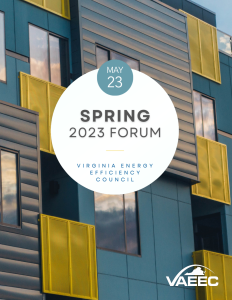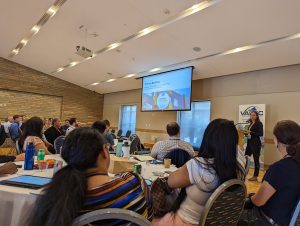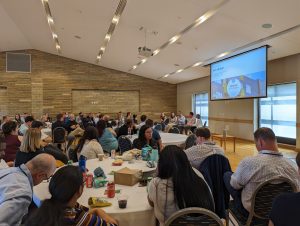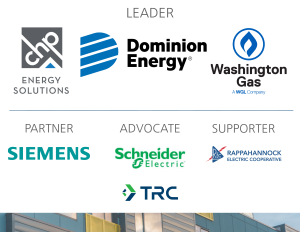Spring 2023 Forum Synopsis

View the event program
Virginia’s energy efficiency industry gathered together to learn and connect at the VAEEC’s annual Spring Forum on May 23rd. Nearly 100 energy efficiency professionals participated in the event, which included a keynote address, business meeting with Board of Directors elections, membership spotlight, plenary session, and networking time. Thank you to our sponsors, speakers, and attendees for making this event a great success!
Prior to the start of the event, around 20 attendees came together to tour the award-winning, LEED Gold-certified Fairfield Area Library. Opened in late 2019, the library is Henrico County’s 18th government or school building to earn LEED certification for sustainable design and construction and reduced environmental impact. Encompassing 45,000 SF, it features LED interior and exterior lighting, third-party verification of its mechanical and electrical systems, and long-term energy performance verification. Building materials include sustainably harvested wood, rapidly renewable cork, and low-emitting materials. The tour was led by Andrea Quilici and Chuck Wray from the project’s architect firm, Quinn Evans, and Carrie Webster, Henrico County‘s Energy Manager.
The Spring Forum then kicked off with an opening presentation from Executive Director, Chelsea Harnish, who provided an update about Virginia’s energy efficiency industry and the organization’s accomplishments from 2022 to today. This included the VAEEC’s 2023-2025 Strategic Plan objectives and our new Energizing Efficiency Campaign.
Next was a keynote address from Theresa Backhus, Director of the Building Innovation Hub (HUB) with the Institute for Market Transformation (IMT). The HUB supports high-performing buildings across D.C., Maryland, and Virginia by connecting decision-makers, localities, contractors, building owners, and others to resources that make buildings energy-efficient and resilient. Theresa shared an overview of the resources the HUB provides, as well as the building decarbonization opportunities available through federal funding. She also gave an overview of the DMV’s building code updates and building energy performance standards with an emphasis on what Virginia localities can do to address energy efficiency in a Dillion Rule state.
“It’s important not to forget that at the end of the day, buildings are for people; they must support the community they surround.” – Theresa Backhus, Building Innovation Hub (IMT)
 Approximately 1/3 of our greenhouse gas emissions are from the new and existing building stock. The HUB emphasizes the importance of transitioning from looking at buildings as the problem to looking at them as the opportunity. And above all, we cannot forget that buildings are for people, which is especially true when you consider that we spend roughly 90% of our lives in buildings. Therefore, they must support the community around them by focusing on energy efficiency, resiliency, and health and safety.
Approximately 1/3 of our greenhouse gas emissions are from the new and existing building stock. The HUB emphasizes the importance of transitioning from looking at buildings as the problem to looking at them as the opportunity. And above all, we cannot forget that buildings are for people, which is especially true when you consider that we spend roughly 90% of our lives in buildings. Therefore, they must support the community around them by focusing on energy efficiency, resiliency, and health and safety.
Next, John Morrill, led the business portion of the event, which started off with our 2023 Board of Directors election. VAEEC members re-elected two board members:
- Bryna Dunn, Moseley Architects (1st full term)
- Leigh Anne Ratliff, Trane Technologies (2nd term)
Members then voted to elect two new directors to the Board:
- McKenna Dunbar, Sierra Club Virginia Chapter
- Lesley Fore, Alliance to Save Energy
We are thrilled to add new voices to our leadership and to continue working with our two re-elected members. We would also like to recognize our outgoing Board members, Maggie Kelley Riggins, with the Southeast Energy Efficiency Alliance, and Joyce Bodoh, with Rappahannock Electric Cooperative, for their outstanding leadership to the organization.
 Attendees were next treated to a round robin of updates and successes from our members before moving into a networking break. After reconvening, the plenary session began. Meeting the Moment for Building Demand touched on the how the federal climate initiatives passed by the Biden administration will change the energy landscape for decades to come, before moving into how experts from across the field are planning to implement successful programs and projects using the funds. The discussion also included how we can make this round of funding more “durable” than that of the American Recovery & Reinvestment Act (ARRA) era to create systemic change and avoid the “one and done” projects.
Attendees were next treated to a round robin of updates and successes from our members before moving into a networking break. After reconvening, the plenary session began. Meeting the Moment for Building Demand touched on the how the federal climate initiatives passed by the Biden administration will change the energy landscape for decades to come, before moving into how experts from across the field are planning to implement successful programs and projects using the funds. The discussion also included how we can make this round of funding more “durable” than that of the American Recovery & Reinvestment Act (ARRA) era to create systemic change and avoid the “one and done” projects.
“We don’t have a shortage of money, but we need an easy button now to effectively deploy it. The Inflation Reduction Act is our window of opportunity to create a unified customer experience.” – Andrew Grigsby, Viridiant
Speakers included:
- Bettina Bergoo, Virginia Energy: Along with moderating the session, Bettina also spoke on Virginia Energy’s role and plans with the federal funding and the guidance currently available for HOMES/HEERHA.
- Andrew Grigsby, Viridiant: Andrew spoke on Viridiant’s success with the BENEFIT grant and how that can serve as a model for future programs. He also went into detail about the need for a unified customer experience that includes financing options available.
- Marco Rubin, Virginia Innovation Partnership Corporation: Marco discussed the startup environment since the passage of the inflation Reduction Act and Bipartisan Infrastructure Law, including looking the economic conditions at the micro-, macro-, and Marco-levels.
- Joyce Bodoh, Rappahannock Electric Cooperative: Given her role as the Director of Energy Solutions and Clean Energy at one of Virginia’s electric cooperatives, Joyce focused on how federal funding can be braided with the federal funding. She also spoke to the importance of customer data access and shared how REC’s summer savings pilot program provided $12k in bill credits to customers and saved REC $70K in wholesale power.
- Kim Strahm, Community Housing Partners: After having developed a successful workforce development program using funds from the 2009 ARRA, Kim shared best practices and lessons learned for developing and implementing programs using federal funding. Through CHP’s position on both the demand- and supply-side of high-performance buildings, Kim kept coming back to the need for a trained workforce.
As always, this event would not have been possible without our sponsors, speakers, and attendees. We would also like to thank the VAEEC Education & Events Committee for helping staff plan such a successful event.
 Be sure to save the date for our fall Energy Efficiency Forum– October 4th (virtual), October 5th (in-person, University of Richmond). We hope to see you there.
Be sure to save the date for our fall Energy Efficiency Forum– October 4th (virtual), October 5th (in-person, University of Richmond). We hope to see you there.
Additional event information, including speaker biographies and sponsor features, can be found in the event program. Event attendees received a PDF of the event’s presentation in the post-event email. Contact info@vaeec.org if you did not receive it. Events photos can be viewed in the photo gallery below.
